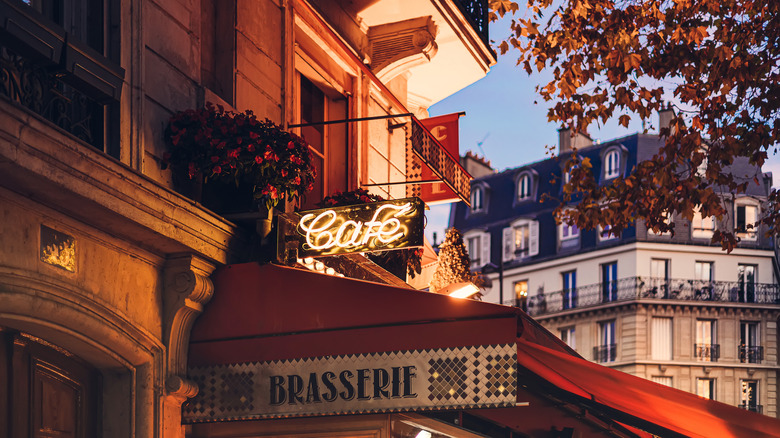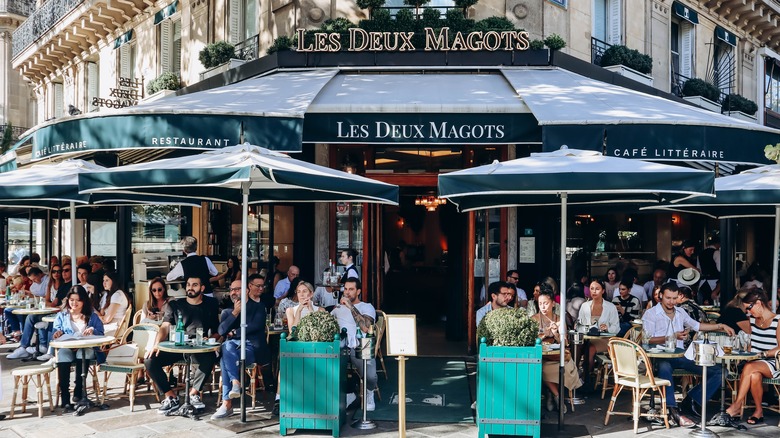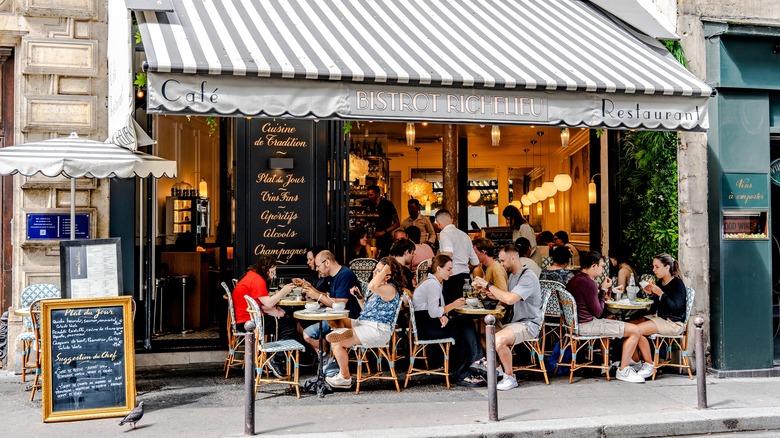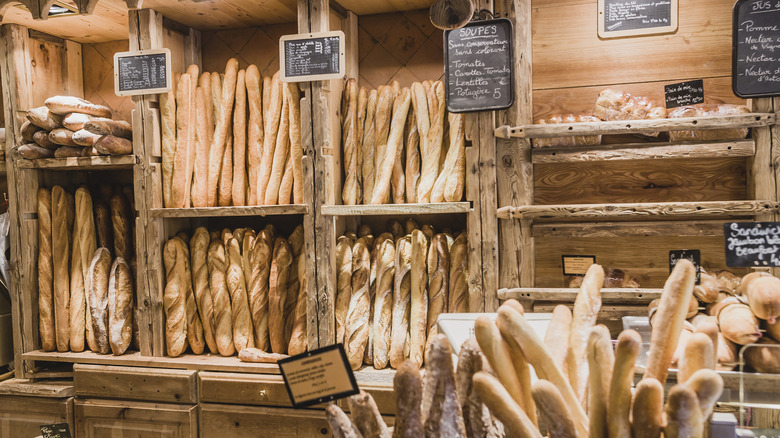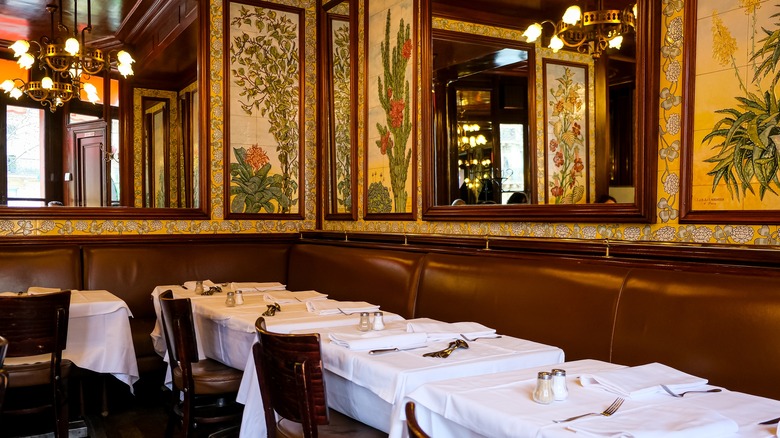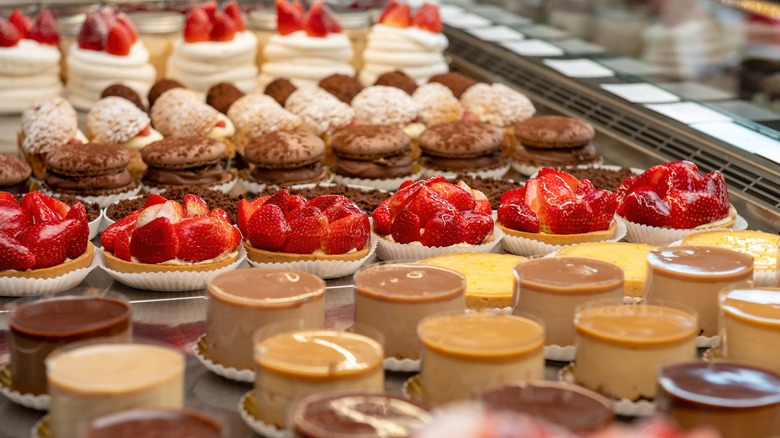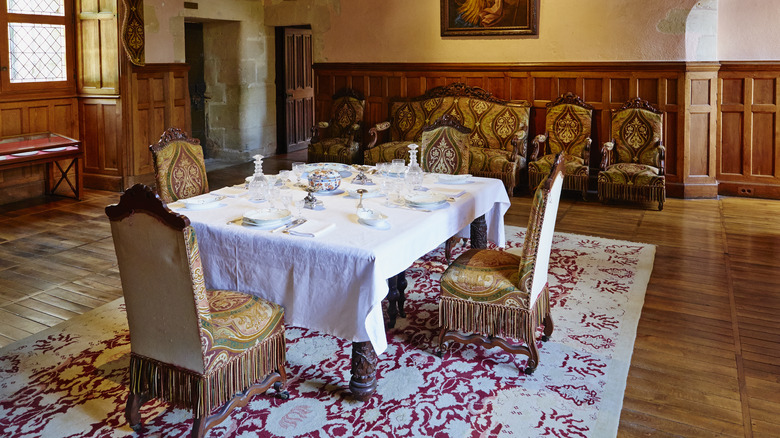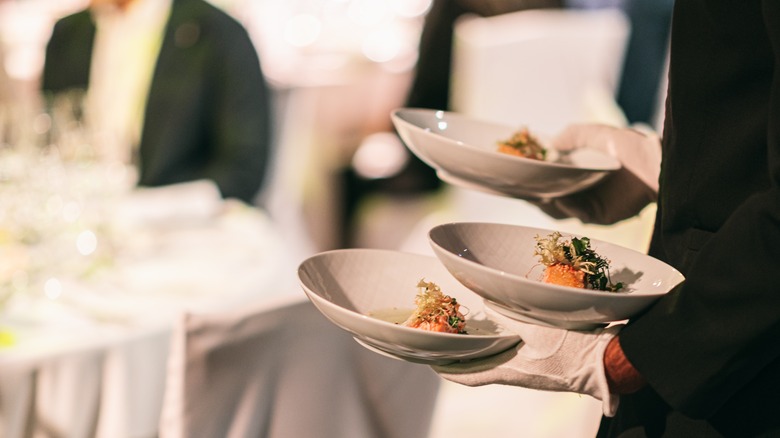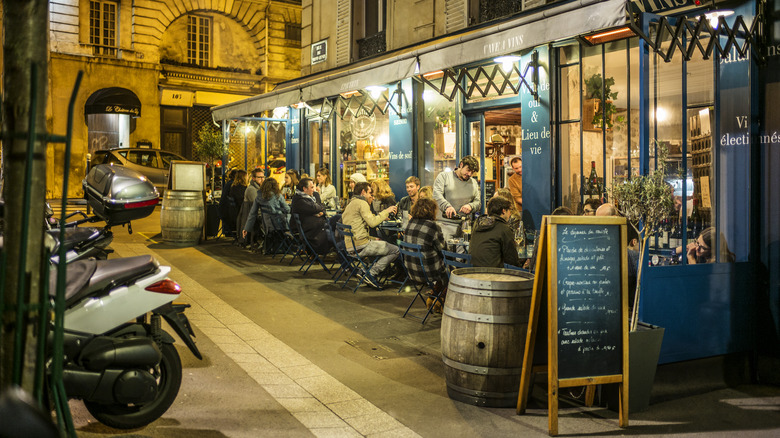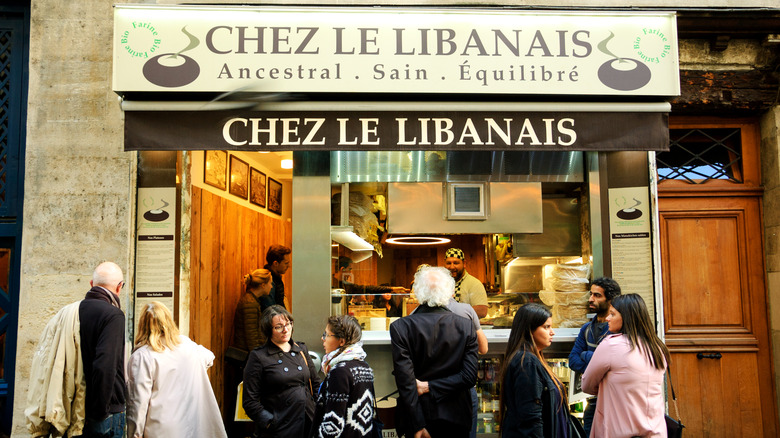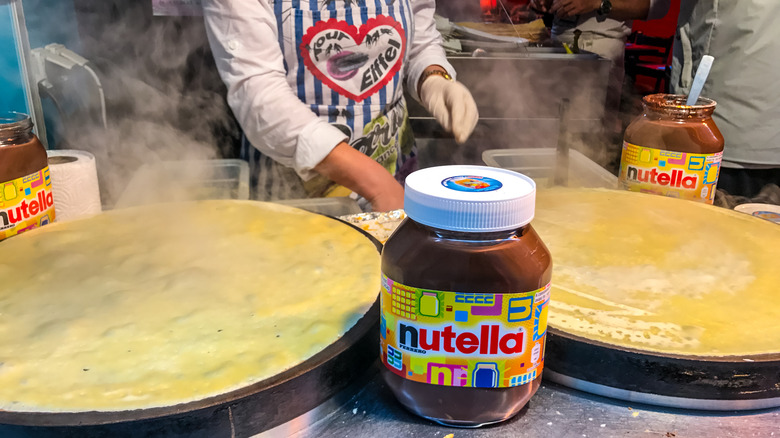10 Types Of French Restaurants And When To Go To Each
France's culinary scene is the stuff foodie dreams are made of. From laid-back cafés and rustic boulangeries to the heights of haute cuisine, you can satisfy just about any taste here. The French are fanatical about their food, and rightfully so. The country has been at the forefront of culinary technique and innovation since the Middle Ages when the French royal court feasted on bountiful spreads in which presentation was paramount. The establishment of formal culinary schools like Le Cordon Bleu in the 19th century further solidified France's reputation as an international epicurean destination.
Highlights of French cuisine include the development of ubiquitous sauces like bechamel (hello, homemade mac and cheese), pastries, and the modern concept of fine dining, epitomized by the Michelin Guide. And you can't talk about French food without mentioning wine. Bordeaux, Burgundy, and Champagne are all regions celebrated for their unique and exceptional vintages.
Suffice it to say, when planning your "Emily in Paris"-inspired trip to France, you have some mouthwatering work cut out for you. The sheer volume of restaurant terminology can be overwhelming, especially if you don't speak the language. As a long-time student of the French language with three recent trips to France under my belt exploring the culinary delights of Paris and Normandy, I've picked up a few helpful insights that might just make your first trip to this gastronomic destination a success to savor. These are the most common types of French restaurants and tips for visiting each.
Café
If you're looking to linger for hours over a single cup of coffee in Paris like Ernest Hemingway or Gertrude Stein, then a café is your best bet. This is where you'll find that quintessential French vibe you've seen in the movies with tiny tables clustered together, spilling out the front of the restaurant onto the street, where friends gather over a drink and stimulating conversation while they watch the world go by. Cafés are made for lingering, opening early in the morning, around 7 a.m. or so, and staying open late into the night.
Drinks are the main event at French cafés. You'll typically find a robust list of coffee-based beverages, tea, beer, wine, and even cocktails. If you're craving that Instagram-worthy, uber-rich French hot chocolate, a Parisian café like Angelina or Carette would do nicely thanks to their over-the-top Belle Époque interiors.
While you'll find light bites on the menu, like pastries and cheese plates, food is very much an afterthought at French cafés. This is really a place to hole up for a catch-up with friends, a laid-back coffee date, or an after-work (or post-sightseeing) wind-down. History buffs should snag a table at historic spots like Les Deux Magots or Café de Flore to follow in the footsteps of Paris' famous artists and intellectuals. While typically touristy spots today, they're still worth a stop for their vintage French ambiance and prime Paris people-watching.
Bistro
A French bistro is a cozy, casual eatery that embodies the ethos of Parisian dining. Traditionally family-run, bistros are known for their intimate, relaxed atmosphere and simple, hearty fare. Unlike cafés, bistros tend to keep set hours for lunch and dinner, though they're typically open fairly late which makes them perfect for laid-back mid-day meals or leisurely dinners after long days of sightseeing.
Due to their more intimate nature, reservations are essential to snag a table at your bistro of choice. When it comes to food, there will often be a few daily specials listed on a classic chalkboard or written on the window for you to peruse before entering, though the standard menu will often include classic French comfort foods like soupe à l'oignon, cassoulet, and duck confit, along with regional cheeses and charcuterie. Just bear in mind that if your stomach isn't used to raw preparations or super-heavy sauces, there are a few French bistro dishes you should consider avoiding.
Paris alone is covered in classic bistros that can range widely in their style and menu, though nearly all maintain a warm and inviting atmosphere characterized by charming decor, small wooden tables, and an eclectic mix of vintage and contemporary elements. Dim lighting, soft music, and the dull buzz of lively conversation create a welcoming space to linger over a leisurely meal. Among the City of Light's most storied spots are Bistrot Paul Bert, Robert et Louise, and La Poule au Pot.
Boulangerie
The quintessential French bakery, a boulangerie is where you'll find house-baked breads and classic pastries. Typically, they open early in the mornings, around 7 a.m., and often stay open until late afternoon or early evening, making them perfect for a quick morning pick-me-up or to stock up for an afternoon picnic in the Jardin du Luxembourg.
The star of a boulangerie is, of course, the bread. Legally speaking, a French bakery can only label itself a "boulangerie" if it makes its dough from scratch, so you know you're getting the real deal. You'll find classic baguettes, pain de campagne, and elaborate specialty loaves, all made using traditional methods and high-quality ingredients. One insider tip: If you want to order that signature French loaf, order a "tradition" instead of a baguette. The latter is a dead giveaway that you're a tourist.
The ambiance of a boulangerie is often bustling yet cozy, with customers lined up at the counter to select their favorites. Many boulangeries have small seating areas where you can enjoy a pastry and a coffee while soaking in the local vibe. Come lunchtime, boulangeries are also popular spots for a quick and easy lunch on the go. They often offer a large cooler with pre-made sandwiches, salads, and thick slices of quiche for a quick mid-day meal. One wallet-friendly tip: Look for the "formule" price to get a meal and a drink or dessert from the pastry case for a set price — it's usually around €14 or less.
Brasserie
While no two restaurants are exactly the same, a brasserie is generally a large airy dining establishment that offers a casually elegant ambiance for enjoying classic French fare. Derived from the French word for "brewery," brasseries were originally known for brewing their own beer, kind of like a British tavern. Nowadays, few brasseries actually brew beer, but they do tend to offer a robust list of local brews alongside an extensive list of wines and sometimes even a full bar. Known for their "service continu" dining style, most neighborhood brasseries are open all day long with non-stop service, making them perfect for those who like to dine outside of typical meal times or for on-the-go tourists.
Brassieries typically specialize in traditional French dishes like coq au vin, steak frites, and boeuf bourguignon. Those with a sweet tooth will want to be sure to save room for classic French desserts like profiterole au chocolate (a giant cream puff served with hot chocolate sauce) and crème brûlée. The atmosphere is usually bustling and vibrant, providing an ideal spot for a leisurely post-Louvre lunch or dinner to rest your feet.
If you're looking to indulge in a classic French dining experience without breaking the bank, peruse the menu or ask your server about prix-fix options. More often than not, brasseries will include a lower set price for a multi-course meal (though typically only at lunch), allowing you to savor more plates at a wallet-friendly price point.
Patisserie
For ultra-fine French desserts that are (almost) too pretty to eat, a patisserie is where you'll want to be. While it's technically a bakery, patisseries and boulangeries differ in that while the latter focuses primarily on bread and daily bakes, a patisserie crafts exquisite desserts that showcase the artistry of French baking. Special occasion desserts and "treat yourself" moments are the order of the day here. If you're lucky, you might even catch a glimpse of the chef pâtissier putting the finishing touches on their latest creation.
Typically open from early morning until late afternoon, patisseries sometimes stay open into the early evening, allowing you ample time to pick up an after-dinner treat between sightseeing and returning to your hotel to change for the night. The offerings at a classic patisserie typically include iconic pastries like macarons, éclairs, and mille-feuille, along with seasonal tarts and delicate cakes. These creations are works of art, featuring impossibly intricate designs and bold flavors, ranging from the classic to the eclectic.
While most locals take their treats to go, many patisseries offer small seating areas where you can savor your selections while enjoying a café au lait or a cup of tea. Among the most famous patisseries in Paris are the Louvre-adjacent Cédric Grolet Opéra and one of the many Pierre Hermé shops around town — the latter is well regarded as making some of the best macarons in France.
Table d'Hôte or Auberge
Translated to "host's table" (and sometimes referred to as an "auberge"), a table d'hôte is a restaurant that is often (though not always) attached to a small hotel, inn, or family-run bed and breakfast. Lesser known to non-French speakers, table d'hôte are typically found in charming countryside settings or small villages, where seasonal produce is bountiful and dining venues are fewer and farther between. The intimate dining venues can range in format and style depending on the type of accommodation to which they are attached. Upscale hotels often feature a formal dining room, while family-owned B&Bs will typically have a more rustic and communal dining style.
Regardless of the formality, what all table d'hôte have in common is a single set menu that changes almost daily based on the seasonal availability of locally and regionally sourced produce and protein. While this is a great way to get a taste of the unique flavors of the region in which you're staying, the single menu option can be limiting, especially for picky eaters or those with dietary restrictions. Be sure to peruse the menu in advance or call ahead to report any allergies and make sure the table d'hôte can accommodate you. If you're open to the experience, this is a great option for those looking for a romantic French countryside escape without a lot of extra planning.
Restaurant gastronomique
To experience the crème de la crème of fine dining in France, nothing less than a restaurant gastronomique will do. A restaurant gastronomique is a fine dining establishment that emphasizes top-tier cuisine, creativity, and culinary artistry. These are your Michelin-starred venues (like Mirazur and Le Pré Catelan), celebrity chef-helmed spots (including Restaurant Le Meurice Alain Ducasse), and upscale venues attached to high-end hotels (such as Le Cinq at Four Season Hotel George V Paris).
Typically open for both lunch and dinner, though with limited hours and tables, most of these upscale spots offer tasting menus that provide a seasonally driven multi-course dining experience, allowing you to savor a range of flavors and dramatic presentations. The style of food at a restaurant gastronomique is characterized by intricate plating (think "Chef's Table"-level finesse) and the use of premium ingredients, often sourced from local farms and markets all paired with sommelier-selected wines. Depending on the restaurant, dishes could include French fine-dining classics like foie gras, expertly prepared fish, and exquisite desserts that showcase the chef's skill and imagination. The ambiance is typically elegant and refined, often featuring sophisticated decor, soft lighting, and attentive service that enhances the overall dining experience.
An evening at a restaurant gastronomique is not a spur-of-the-moment decision. These high-end venues often book up months in advance. If you do manage to snag a coveted reservation, you'll want to dress to impress and plan to spend several hours lingering over course after course of indulgent fare.
Bar à vin
If you're craving an informal yet stylish night out, a bar à vin should be on your shortlist of hot spots. As its name suggests, a bar à vin is a French wine bar. Unlike their often upscale U.S. counterparts, French wine bars tend to be super casual spots where sporadic seating is found on wine barrels and the (mostly) French wines take center stage. Typically, a bar à vin opens in the late afternoon and remains open until late at night (or early in the morning), making them ideal for leisurely evenings. The food typically comes second here, where select light bites are offered to complement the wines — think charcuterie boards, artisinal cheeses, and freshly baked bread. Some bars à vin may also feature heartier bistro-style dishes, but the focus is always on the wine pairings.
The ambiance tends to be cozy and inviting, with dim lighting, intimate seating arrangements, and a relaxed yet sophisticated vibe — very "je ne sais quois" — with a dress code to match. Almost anything goes at a bar à vin, though you'll typically find townies (especially in Paris) dressed in a stylish and sophisticated fashion. Soft background music and lively conversation waft through the air, adding to the cozy-chic feel. Thanks to its casual and relaxed ambiance, a bar à vin is a prime spot for a date night, a low-key weekend hangout with a group of friends, or just for enjoying a quiet evening solo with a good book.
Service rapide
The French equivalent of fast food, service rapide restaurants span a wide range of options, from international chains like McDonald's to more locally favored street food stalls offering fresh, cooked-to-order meals. While global chains are easily found in urban areas, many French locals and travelers prefer the latter option, as it aligns with the country's appreciation for quality, flavorful food, even in a quick-service setting. These offerings can be quite diverse, ranging from savory falafel wraps and crêpes to bento boxes, ramen, and other international delights. Classic French lunch foods like jambon-beurre (ham and butter, also known as a "parisien") sandwiches, and croque-monsieurs also make frequent appearances.
Service rapide spots are typically grab-and-go operations with limited or no seating. On occasion, you might find small, casual seating arrangements nearby, but the emphasis is on convenience and speed. These venues are especially popular in bustling city centers like Paris, market areas, and near major attractions, making them ideal for a quick bite between sightseeing excursions. This way, you can enjoy fresh, wallet-friendly meals without the time commitment of a sit-down restaurant. Plus, service rapide restaurants typically offer all-day dining (or "service continu") making them ideal for grabbing a bite in between traditional meal times or even late at night. For a taste of Paris' street food scene, plan a visit to Marché des Enfants Rouges, the city's oldest street food market and a hub of fresh grab-and-go options.
Crêperie
While technically a subcategory of service rapide restaurants, crêperies are so quintessentially French that they've earned a special place of their own on our list. Though there are full-fledged restaurants that specialize in crêpes, there's a unique charm to ordering one from a simple street stall where this beloved dish is often prepared with a straightforward, traditional touch.
As you stroll through the lively streets of France, particularly in Paris or the region of Brittany, keep an eye out for these no-frills street stalls. Equipped with just a crêpe pan or two, and a handful of classic fillings, these vendors offer a taste of authentic French street food. The experience is delightfully simple: You approach the counter, place your order with the vendeur or vendeuse, and watch as they pour the batter onto the hot griddle. With a few expert strokes, they spread the batter into a thin, delicate layer, cooking it to perfection before adding your chosen fillings.
Whether you're in the mood for something sweet like Nutella, sugar and lemon, or a savory option such as ham and cheese, a freshly made crêpe is a perfect snack to enjoy as you wander through the bustling city streets. Particularly in iconic neighborhoods like Montmartre, grabbing a hot crêpe to-go adds a tasty touch to the quintessential French experience. Light, fluffy, and delicious, it's the ideal treat for any time of day, especially when there's a slight chill in the air.
